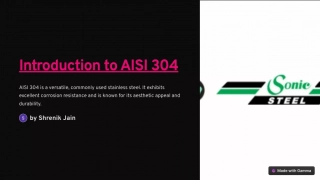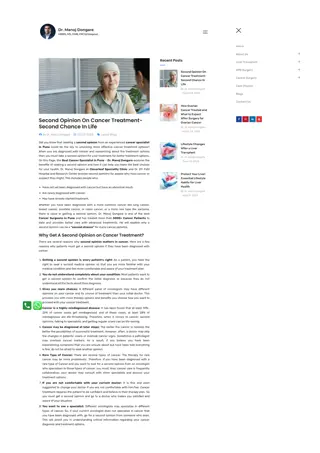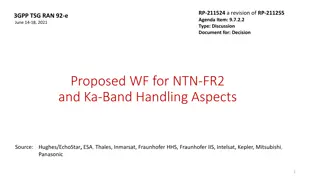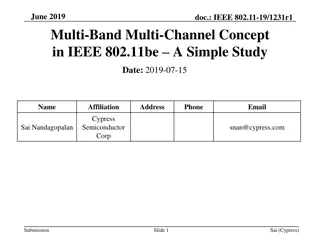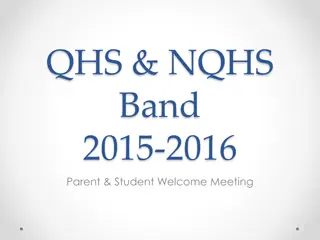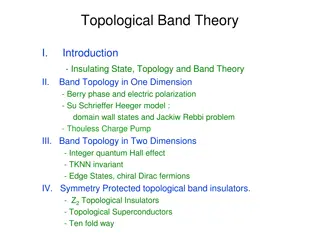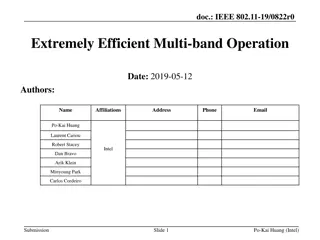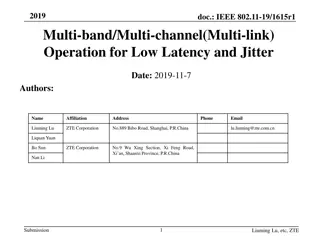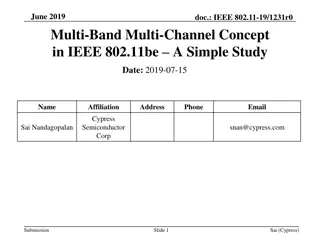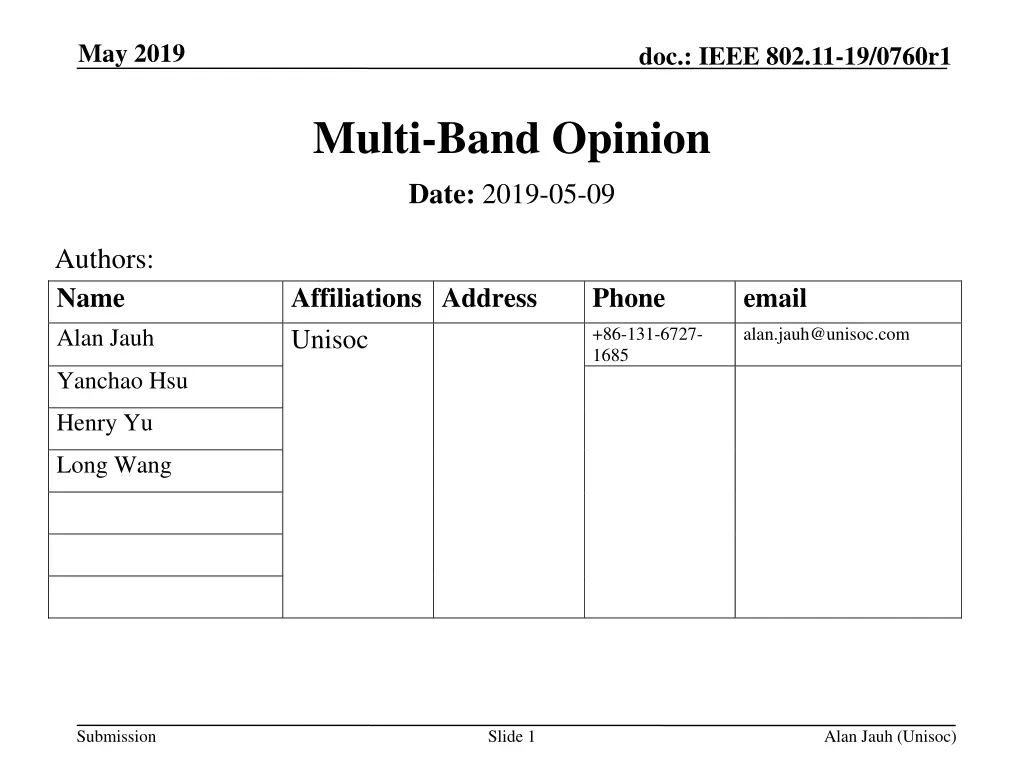
IEEE 802.11 Multi-Band Operation
In this document from May 2019, Alan Jauh from Unisoc discusses a proposed Joint MAC with multiple concurrent PHY architecture for multi-band operation in IEEE 802.11 standards. The architecture aims to reduce latency while remaining backward compatible with legacy devices. Different channel configurations and examples are presented to illustrate the concept of multiple links system and joint MAC with multiple concurrent PHY.
Download Presentation

Please find below an Image/Link to download the presentation.
The content on the website is provided AS IS for your information and personal use only. It may not be sold, licensed, or shared on other websites without obtaining consent from the author. If you encounter any issues during the download, it is possible that the publisher has removed the file from their server.
You are allowed to download the files provided on this website for personal or commercial use, subject to the condition that they are used lawfully. All files are the property of their respective owners.
The content on the website is provided AS IS for your information and personal use only. It may not be sold, licensed, or shared on other websites without obtaining consent from the author.
E N D
Presentation Transcript
May 2019 doc.: IEEE 802.11-19/0760r1 Multi-Band Opinion Date: 2019-05-09 Authors: Name Alan Jauh Affiliations Address Unisoc Phone email +86-131-6727- 1685 alan.jauh@unisoc.com Yanchao Hsu Henry Yu Long Wang Submission Slide 1 Alan Jauh (Unisoc)
May 2019 doc.: IEEE 802.11-19/0760r1 Introduction The multi-band operation has been discussed during the EHT discussion[1~9] We propose a Joint MAC + multiple concurrent PHY architecture for multi-band operation. As compare to multiple concurrent devices(e.g. 2.4GHz+5GHz devices) case, this proposed architecture can Reduce worst case latency Still be backward compatible to legacy devices Submission Slide 2 Alan Jauh (Unisoc)
May 2019 doc.: IEEE 802.11-19/0760r1 Our Thought of Multiple Links System Ch1 and Ch2 are different channels that can be in the same or different bands, e.g. one is in 2.4GHz and the other is in 5GHz The traffic is put into the queue and use all or part of the available channels to send MAC LMAC2 LMAC1 AP PHY2 PHY1 Ch 1 Ch 2 Joint MAC or Unified MAC PHY1 PHY2 LMAC1 LMAC2 STA MAC Submission Slide 3 Alan Jauh (Unisoc)
May 2019 doc.: IEEE 802.11-19/0760r1 Joint MAC Multiple Concurrent PHY Assumption: multiple PHY can operate concurrently in different channel(band) Each packet can TX/RX from one of the allowed channel(s) each packet can has different allowed channel(s) Example of the key concept: 1. A packet that is allowed to be transmitted in channel 1 or channel 2, and this packet is prepared in both queuing lists of channel 1 and channel 2 2. If this packet is transmitted via one of the channel (e.g. channel 1), then remove this packet from the other queuing list (channel 2) Submission Slide 4 Alan Jauh (Unisoc)
May 2019 doc.: IEEE 802.11-19/0760r1 Example (1/) Memory Simple TX example, no aggregation, non-QoS Two PHYs, one is in channel 1, the other one is in channel 2 All packets are allowed to be transmitted by any PHY The incoming packets are prepared in both queuing lists ... E D Incoming data C B A ... Descriptors ... E E D D Channel 1 queuing list Channel 2 queuing list C C B B A A Submission Slide 5 Alan Jauh (Unisoc)
May 2019 doc.: IEEE 802.11-19/0760r1 Example (2/) Memory If channel 1 acquires the TX opportunity, then packet A is transmitted via channel 1(shown in RED) and it is removed from channel 2 queuing list If channel 2 acquires the TX opportunity, then packet B is transmitted via channel 2 and it is removed from channel 1 queuing list ... E D Incoming data C B A ... Descriptors ... E E D D Channel 1 queuing list Channel 2 queuing list C C B B A A Submission Slide 6 Alan Jauh (Unisoc)
May 2019 doc.: IEEE 802.11-19/0760r1 Example (3/) Memory If channel 1 is blocked temporarily for some reason, the packets can still be transmitted via channel 2 In this scenario, the traffic assigned in channel 1 might have worst case latency using current method This proposal can reduce the worst case latency ... E D Incoming data C B A ... Descriptors ... E E D D Channel 1 queuing list Channel 2 queuing list C C B B A A Submission Slide 7 Alan Jauh (Unisoc)
May 2019 doc.: IEEE 802.11-19/0760r1 Example (4/) Memory If packet C and D are allowed to be transmitted via channel 1 only, they will only be prepared in the channel 1 queuing list The traffic to a legacy device is allowed in its operating channel only ... E D Incoming data C B A ... Descriptors ... E D Channel 1 queuing list Channel 2 queuing list C E B B A A Submission Slide 8 Alan Jauh (Unisoc)
May 2019 doc.: IEEE 802.11-19/0760r1 Conclusion We propose a novel joint MAC and multiple concurrent PHY architecture and use a simple example to present this concept Next step: more factors need to be considered, e.g. aggregation, QoS, security, re-transmission, etc. Submission Slide 9 Alan Jauh (Unisoc)
May 2019 doc.: IEEE 802.11-19/0760r1 References [1] 802.11-18/1155r1 Multi-AP Enhancement and Multi-Band Operations [2] 802.11-18/1161r0 EHT Technology Candidate Discussions [3] 802.11-18/1171r0 View on EHT Objectives and Technologies [4] 802.11-18/1518r0 EHT Multi-Channel Operation [5] 802.11-18/1525r1 EHT features for Multi-Band Operation [6] 802.11-18/1908r0 Overview of Full Duplex over Multi- Band (FD-MB) for EHT [7] 802.11-19/108r1 Discussion on Multi-Band for EHT [8] 802.11-19/367r0 Performance on Multi-band Operation [9] 802.11-19/360r0 MAC Architectures for EHT Multi-band Operation Submission Slide 10 Alan Jauh (Unisoc)
May 2019 doc.: IEEE 802.11-19/0760r1 Backup Slides Submission Slide 11 Alan Jauh (Unisoc)
May 2019 doc.: IEEE 802.11-19/0760r1 Centralized Queuing List (1/) Ch1 and Ch2 are different channels that can be in the same or different bands, e.g. one is in 2.4GHz and the other is in 5GHz The traffic is put into the centralized queue and use all or part of the available channels to send MAC LMAC AP PHY2 PHY1 Ch 1 Ch 2 Joint MAC or Unified MAC PHY1 PHY2 LMAC STA MAC Submission Slide 12 Alan Jauh (Unisoc)
May 2019 doc.: IEEE 802.11-19/0760r1 Centralized Queuing Memory Packets A, B, E are allowed to be transmitted via both channels Packet C and D are allowed to be transmitted via channel 1 only ... E D Incoming data C B A Descriptors ... E(1,2) D(1) Centralized queuing list C(1) B(1,2) A(1,2) Submission Slide 13 Alan Jauh (Unisoc)
May 2019 doc.: IEEE 802.11-19/0760r1 Centralized vs. Parallelized Queuing ... E(1,2) Descriptors Packets A, B, E are allowed to be transmitted via both channels Packet C and D are allowed to be transmitted via channel 1 only D(1) Centralized queuing list C(1) B(1,2) A(1,2) Dispatch ... ... E D Channel 1 queuing list Channel 2 queuing list C E B B Removal module to remove the redundant queuing list after transmission A A Submission Slide 14 Alan Jauh (Unisoc)

